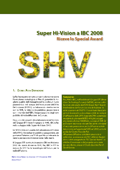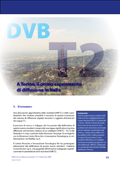 |
SHV - Super Hi-Vision at IBC 2008 and the Special Award
Rai, NHK and BBC as part of the EBU BTF group (Broadcast Technology Futures) are collaborating to study dell'SHV (Super High Vision), the television of the future, with a definition 16 times higher than HDTV . Rai's contribution to the project is focused on developing technologies for SHV broadcasting: SHV signal, compressed using the standard MPEG-4/H.264, occupies a band of about 140 Mbit / s, and thanks to DVB-S2 can be transmitted by satellite. DVB-S2, second-generation standard for satellite broadcasting, was developed by DVB in 2003, under the chairmanship of the Rai Research Centre.
The first satellite broadcasting took place in September at IBC 2008 in Amsterdam and the event was awarded the "IBC Special Award. In October, demonstrations of the project were held in Rome at the "Circolo Sportivo Rai Tor di Quinto".
|
 |
DVB-T2 in Turin, the First Broadcasting Experiment in Italy
The first experiment in Italy for the broadcasting of a multiplex based on the new DVB-T2 occurred in Turin. Rai, at the Research Center, held a meeting with the professionals who were able to evaluate the performance of the system. Through the use of MPEG-4 AVC encoding and increase transmission capacity, it has been possible to broadcast a multiplex consisting of four programs in high definition (HDTV), using the transmitter of Raiway Eremo (Torino).
|
 |
DVB-T2 - the new DTT Platform
by V. Mignone, A. Morello, g. Russo, P. Talone
DVB-T2 is born, the new platform of digital television for terrestrial broadcasting to the terminal or laptop, came to light just over a decade after the standards currently in operation (DVB-T). Its performances are close to the excellent theoretical ones and it offers tangible benefits in terms of increased transmission capacity in the case of equal occupied bandwidth, or better radio coverage for the same transmit power than DVB-T. The increase in transmission capacity can be quantized at almost 50%, with the new source coding (MPEG-4 AVC), this advantage becomes overwhelming: nearly 300% if we think in terms of number of programs that are carried with the same quality. In fact the couple DVB-T2 / MPEG-4 is not only the technology to triple the programs carried by a DTT multiplex for the same bandwidth occupied, it is also the ideal driver for the introduction of HDTVn, which can replace traditional TV almost without causing decrease in the number programs currently broadcast. The transition to DVB-T2 does not imply significant changes in the transmitters and the user receiving antennas, but requires replacement of receivers, whcich could be adapted toHDTV reception, not possible with DVB-T decoders.
This article provides a description of technologies used by the DVB-T2 and presents some simulation results that demonstrate how the system meets the business requirements behind the process of standardization, and in some cases significantly exceeds them. |